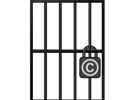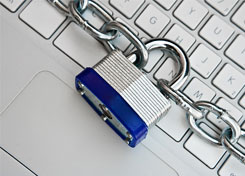Cyber Plagiarism & Statistics
 Plagiarism is a perennial temptation for students and an eternal challenge for teachers and writers, especially in the age of the Internet. An event during the summer of 2006, however, seemed almost a re-invention of plagiarism, at least to some who responded to it.
Plagiarism is a perennial temptation for students and an eternal challenge for teachers and writers, especially in the age of the Internet. An event during the summer of 2006, however, seemed almost a re-invention of plagiarism, at least to some who responded to it.
In June 2006 a message was emailed to fraternity and sorority chapters across the country advertising a new electronic repository for down-loadable college and university papers, as well as articles on various topics. The site was called "writing sucks" (link removed intentionally), and featured the slogan, Download your Workload.
Members of the Alliance for Computers and Writing (ACW) list-serve list fumed and argued about plagiarism in general and Writing Sucks
in particular.
Sources for plagiarized text
 Traditionally, a person simply:
Traditionally, a person simply:
copied paragraphs from various scholarly journals or books in the library,
orremoved an old term paper from the files in his/her fraternity and copied some, or all, of it.
In the late 1960s, commercial services began selling term papers to students, sometimes under the euphemistic name of, academic research services
. These services are particularly repugnant, as these businessmen are making a profit from the fraudulent acts of students, as well as damaging the integrity of grades and degrees from schools and colleges.
Additionally, since the mid-1990s, students can simply download material from the Internet, without the bother of retyping the text. While the Internet is a great resource for plagiarists, it can also be a great resource for professors who are suspicious and want to take a few minutes with search engines, in an attempt to find the true source. Further, some commercial anti-plagiarism services have begun to prepare databases of essays, term papers, etc. for comparison with a student's work submitted in a class, in a large-scale attempt to find plagiarism by students. Furthermore, the existence of free material on the Internet is likely to diminish, if not kill, the business of selling term papers from stock. Unfortunately, there may continue to be a business for custom-prepared papers.
How common is plagiarization by students? No one really knows, because most plagiarization is either undetected or unreported. Julie Ryan, an instructor at George Washington University, found that 7 of 42 students plagiarized most or all of their papers
in a class during the Fall 1997 semester. She says that, in the Spring 1998 semester, again 17% of the students plagiarized their entire papers.
But wait! That 17% only represents the plagiarists that she caught by using the Alta Vista search engine on the Internet, a method that will not find students who plagiarized from books, scholarly journals, old term papers by other students, material sold by term paper mills, .... So the true incidence of plagiarism among students is higher than one in six. Still, one in six is unacceptably high and represents a serious erosion of quality and integrity in colleges across the globe, especially in USA, and UK.
Plagiarism statistics in Schools:
 Alarming Statistics: 36% of undergraduates have admitted to plagiarizing written material, says 1997 Psychological Record study.
Alarming Statistics: 36% of undergraduates have admitted to plagiarizing written material, says 1997 Psychological Record study.
- 4 out of 5 high achievers surveyed in 1998 admitted to cheating on school work according to publishers of Who's Who Among American High School Students.
- More than half of those students said such cheating was
no big deal,
and practically none got caught.
Plagiarism statistics in Universities:
Alarming Statistics: 66% of 16,000 students from 31 prestigious U.S. universities have cheated at least once, says 1991 Rutgers University study.
- 12% of those reported themselves as regular cheaters. This means nearly seven out of ten students cheat, and at least one of those cheats all the time!
- Cheating on campus increased an estimated 744% from 1993 to 1997, says University of California-Berkley officials.
Global Plagiarism Statistics:
- A study by The Center for Academic Integrity found that almost 80% of college students admit to cheating at least once.
- A survey by the Psychological Record shows that 36% of undergraduates have admitted to plagiarizing written material.
- A poll conducted by US News and World Reports found that 90% of students believe that cheaters are either never caught or have never been appropriately disciplined.
- A study conducted by Ronald M. Aaron and Robert T. Georgia: Administrator Perceptions of Student Academic Dishonesty in Collegiate Institutions found that 257 chief student affairs officers across the country believe that colleges and universities have not addressed the cheating problem adequately.
- According to the Gallup Organization (October 6-9, 2000), the top two problems facing the United States are: 1) Education and 2) Decline in Ethics (both were ranked over crime, poverty, drugs, taxes, guns, environment, and racism, to name a few).
- A national survey published in Education Week found that 54% of students admitted to plagiarizing from the Internet; 74% of students admitted that at least once during the past school year they had engaged in "serious" cheating; and 47% of students believe their teachers sometimes choose to ignore students who are cheating.
This article has been sourced (as is) from rbs2.com
Avoid getting penalized: Effective Plagiarism Checking Solutions
CheckForPlagiarism.net provides a unique opportunity for you to check your submitted documents' through our patented plagiarism checking engine, identifying all instances of either intentional (deliberate) or unintentional (non-deliberate) attempts at plagiarism. Our service is unique, simply because, unlike our competitors or free plagiarism checking services we check all submitted documents' through a host of repositories, including Internet-based (online) resources (e.g. blogs, websites, live and cached Internet links, message boards, PDFs etc.) and paper-based (offline) resources (e.g. books, articles, academic and professional journals, magazines etc.).
If the submitted document is cited incorrectly, or not cited at all, our software can still detect the sources used and identify them in the plagiarism report. This provides an opportunity for the submitter to correct his/her document before finalizing it.
Furthermore, our patented sentence structure & synonym plagiarism detection approach identifies and eliminates the threat of penalties which may be caused due to incorrect paraphrasing.
Our plagiarism report is extremely easy to read. Highlighting all 'offending' content in a submitted document for easy corrections. We are so confident in the ability of our service, that we offer a full money-back guarantee.
CheckForPlagiarism.net is backed by a full money-back guarantee, that is how confident we are in the ability of our service and
the strength of our plagiarism checking engine. Our service is currently in use by thousands of students, teachers, educators, academic, and professional institutions world-wide.
In addition to institutional accounts, we enjoy the confidence of over 100,000 individual accounts (including students, lawyers, doctors, educationists, etc.), who utilize our service on a daily basis. In conclusion, we'd simply like to say this, give us a risk-free trial today, we guarantee you won't be disappointed!
- plagiarism checking accounts for students
- plagiarism checking accounts for teachers, educators, and academic institutions (schools, colleges, and universities)
- plagiarism checking accounts for professionals, writers, bloggers, researchers
- document comparison (compare multiple documents for similarities)
- service features
- compare our service with our competitors
- sample plagiarism report
- advantages of paid plagiarism checking over free alternatives
- plagiarism law, research, and statistics (2015)


